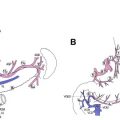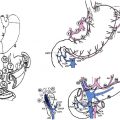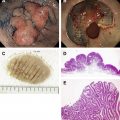Several guidelines are used for cancer therapy throughout the world. The Japan Gastric Cancer Association guideline, whereby standard surgery for T2 to T4 curable gastric cancer is defined as more than two-thirds gastrectomy with D2 dissection, are widely followed, with further data being gathered from either single institutions or nationwide registry. In the East, D2 dissection shows much better results than less extended surgery followed by adjuvant treatment. Adjuvant chemotherapy without radiotherapy shows significantly better survival results than surgery alone only when D2 dissection is applied. Without good local control, including regional lymph node metastasis, the cure rate cannot be high.
Guidelines for the standard treatment of gastric cancer
Several guidelines are used for cancer therapy throughout the world. In the Japan Gastric Cancer Association (JGCA) guideline, standard surgery for T2 to T4 curable gastric cancer is defined as more than two-thirds gastrectomy with D2 dissection. In the 2010 European Society of Medical Oncology’s guideline, the standard surgery for curable gastric cancer is the D2 gastrectomy. Of note, this is the first time this society has clearly advocated for the D2 approach. The National Comprehensive Cancer Network (NCCN) guidelines, commonly followed in the United States, recommend that gastric resections include regional lymphadenectomy to include the perigastric lymph nodes (D1) and those along the named vessels of the celiac axis (D2), with a goal of examining at least 15 or more lymph nodes.
Stage-specific results of resected gastric cancer in the West and East
The JGCA-maintained registry analyzed a total of 11,261 patients who underwent gastric resection in 2001. The 5-year overall survival (OS) by UICC TNM stage (sixth version) was as follows: stage IA, 91.8%; stage IB, 84.6%; stage II, 70.5%; stage IIIA, 46.6%; stage IIIB, 29.9%; stage IV, 16.6%. Although the standard treatment at that time was surgery alone, an unknown proportion of those undergoing surgery may also have received adjuvant treatment either through enrollment into clinical trials or by doctor’s or patient’s choice.
Another available source of information regarding gastric cancer survival is obtained through single-institution reporting. Five-year OS after a total gastrectomy of 881 patients undergoing a total gastrectomy between 1995 and 2001 at Asan Medical Center, Korea, was 94.6%, 90.8%, 76.7%, 55.7%, 41.3%, and 15.4% for stage IA, IB, II, IIIA, IIIB, and IV, respectively. From another Korean institution, National Seoul University Hospital, the results of 10,783 consecutive patients who were surgically treated between 1970 and 1996 were reported. Five-year OS was 92.9%, 84.2%, 69.3%, 45.8%, 29.6%, and 9.2% for stage IA, IB, II, IIIA, IIIB, and IV, respectively. Differences in these results seem attributable mainly to the period of inclusion and improvement over time. Selection bias hampers straight comparison with nationwide registry.
The nationwide results of the United States by the National Cancer Data Base (NCDB) were reported for the cohort treated between 1985 and 1996. Stage-specific OS was 78%, 58%, 34%, 20%, 8%, and 7% for stage IA, IB, II, IIIA, IIIB, and IV, respectively ( Table 1 ). More recent data, after the results of Intergroup study 0116 (INT 0116), have yet to be published in medical journals. According to the report by Enestvedt and colleagues, 36.8% of patients surgically staged from IB to III underwent adjuvant chemoradiotherapy after gastric resection between 2001 and 2006 in the state of Oregon. Stage-specific 5-year OS was approximately 13%, 13%, and 5% for stage IB, II, and III, respectively. These results are unacceptably poor, explained by the extremely low percentage of proper adjuvant treatment, correct staging, or adequate surgery. With this kind of data base it is not easy to obtain the precise details of patients’ background, and comparison is not easy.
| JGCA Registry | SNUH | NCDB | |
|---|---|---|---|
| Period | 2001 | 1970–1996 | 1985–1996 |
| Stage IA | 91.8 | 92.9 | 78 |
| Stage IB | 84.6 | 84.2 | 58 |
| Stage II | 70.5 | 69.3 | 34 |
| Stage IIIA | 46.6 | 45.8 | 20 |
| Stage IIIB | 29.9 | 29.6 | 8 |
| Stage IV | 16.6 | 9.2 | 7 |
| Total patients | 11261 | 10783 | 49756 |
Stage-specific results of resected gastric cancer in the West and East
The JGCA-maintained registry analyzed a total of 11,261 patients who underwent gastric resection in 2001. The 5-year overall survival (OS) by UICC TNM stage (sixth version) was as follows: stage IA, 91.8%; stage IB, 84.6%; stage II, 70.5%; stage IIIA, 46.6%; stage IIIB, 29.9%; stage IV, 16.6%. Although the standard treatment at that time was surgery alone, an unknown proportion of those undergoing surgery may also have received adjuvant treatment either through enrollment into clinical trials or by doctor’s or patient’s choice.
Another available source of information regarding gastric cancer survival is obtained through single-institution reporting. Five-year OS after a total gastrectomy of 881 patients undergoing a total gastrectomy between 1995 and 2001 at Asan Medical Center, Korea, was 94.6%, 90.8%, 76.7%, 55.7%, 41.3%, and 15.4% for stage IA, IB, II, IIIA, IIIB, and IV, respectively. From another Korean institution, National Seoul University Hospital, the results of 10,783 consecutive patients who were surgically treated between 1970 and 1996 were reported. Five-year OS was 92.9%, 84.2%, 69.3%, 45.8%, 29.6%, and 9.2% for stage IA, IB, II, IIIA, IIIB, and IV, respectively. Differences in these results seem attributable mainly to the period of inclusion and improvement over time. Selection bias hampers straight comparison with nationwide registry.
The nationwide results of the United States by the National Cancer Data Base (NCDB) were reported for the cohort treated between 1985 and 1996. Stage-specific OS was 78%, 58%, 34%, 20%, 8%, and 7% for stage IA, IB, II, IIIA, IIIB, and IV, respectively ( Table 1 ). More recent data, after the results of Intergroup study 0116 (INT 0116), have yet to be published in medical journals. According to the report by Enestvedt and colleagues, 36.8% of patients surgically staged from IB to III underwent adjuvant chemoradiotherapy after gastric resection between 2001 and 2006 in the state of Oregon. Stage-specific 5-year OS was approximately 13%, 13%, and 5% for stage IB, II, and III, respectively. These results are unacceptably poor, explained by the extremely low percentage of proper adjuvant treatment, correct staging, or adequate surgery. With this kind of data base it is not easy to obtain the precise details of patients’ background, and comparison is not easy.
| JGCA Registry | SNUH | NCDB | |
|---|---|---|---|
| Period | 2001 | 1970–1996 | 1985–1996 |
| Stage IA | 91.8 | 92.9 | 78 |
| Stage IB | 84.6 | 84.2 | 58 |
| Stage II | 70.5 | 69.3 | 34 |
| Stage IIIA | 46.6 | 45.8 | 20 |
| Stage IIIB | 29.9 | 29.6 | 8 |
| Stage IV | 16.6 | 9.2 | 7 |
| Total patients | 11261 | 10783 | 49756 |
Overall survival in various clinical trials in the West and East
To know exactly the stage-specific OS by surgery alone, the most reliable way is to analyze the results of the surgery-alone arm of clinical trials that have evaluated some kind of new treatment in comparison with a surgery-alone arm as control. Since 2007, when the results of INT-0116, the MAGIC trial, and ACTS-GC became available, it has become difficult to carry out a randomized controlled trial (RCT) having surgery alone as control.
In Japan the results of the surgery-alone arm of the ACTS-GC study, in which 1059 patients were enrolled, are available. In this trial, only stage II and IIIA/B by the Japanese classification were included. These patients can be restaged by UICC TNM classification. Some patients in stage III in the Japanese classification were classified as stage IV by TNM classification. Five-year OS was 70.8%, 56.2%, 40.1%, and 42.7% for UICC stage II, IIIA, IIIB, and IV, respectively in the surgery-only group. In the Dutch Gastric Cancer Study, the 5-year OS was 81%, 61%, 42%, 28%, 13%, and 28%, for stage IA, IB, II, IIIA, IIIB, and IV, respectively. Although the Italian Gastric Cancer Study was a phase 2 study, they reported stage-specific survival due to a larger number of patients included. As shown in Table 2 , their results are somewhere between those of the ACTS-GC and the Dutch study.
| ACTS-GC | Dutch D1 vs D2 | Italian P2 | |
|---|---|---|---|
| Stage IA | 81 (69) | 95.0 (53) | |
| Stage IB | 61 (64) | 87.5 (22) | |
| Stage II | 70.2 (278) | 42 (66) | 57.5 (31) |
| Stage IIIA | 56.2 (153) | 28 (72) | 42.5 (37) |
| Stage IIIB | 40.1 (53) | 13 (39) | 22.5 (25) |
| Stage IV | 42.7 (35) | 28 (18) | 2.5 (23) |
| Total patients | 519 | 328 | 191 |
Stay updated, free articles. Join our Telegram channel

Full access? Get Clinical Tree






